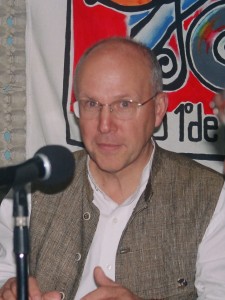Sunday
Video, Audio, PhotosPresident Interviewed on Buddhist Geeks
Buddhist Geeks co-founder Vince Horn interviewed Richard Reoch, the President of Shambhala, in a podcast aired on buddhistgeeks.com last month. In case you missed it…
Listen to the podcast:
Download
Vince: Chogyam Trungpa taught a lot on of enlightened society. And the name Shambhala itself, I know, is a reference to Shangri-La, which is a mythical, sort of, enlightened culture—an Asian culture that existed somewhere where everyone was, sort of, enlightened. And as far as you understand it, what was Trungpa’s vision, or his, sort of, teaching on this idea of enlightened society?
Richard: Well, Trungpa Rinpoche, as I think everybody knows, was an extraordinary figure in the history of the Tibetan Buddhist world. And he said that when the Chinese Army first entered Tibet, when he was a young man, he was in his teens. As soon as he heard this news he said the he immediately realized that there had to be another way to organize human society. And he said that from that moment, what he called his Shamhbala vision never waned.
So, whereas some strands within, you know, the huge family of Buddhism are, to some extent, you could say, like, a personal path. Such as the Path of the Yogi, or the Path of the Solitary Scholar, which of course, does not mean that the motivation of those practitioners is not to help vast numbers of human beings, but the manifestation tends to be more personal and more individual. Well, in contrast to that, you could say that Chogyam Trungpa’s vision, as he described it at that moment, was in fact profoundly societal. That he was concerned with the profound issues of human aggression. What he referred to later as manifestations of materialism. He talked about our living in a dark age. And part of the legend of Shambhala you could say is that, that it is precisely in such dark times, which are characterized by extreme aggression and extreme greed, that these precious teaching arise. And the essence of those teachings are said to lay the foundation for, as you said, enlightened society. So, rather than the notion that you get enlightened first, and then, as it were, help society. Really embedded in this extraordinary set of teachings is the notion of group enlightenment.
So, even within the Tibetan Buddhist tradition, when he came to the West, Trungpa Rinpoche was, some might say, was like a heretic, or some might say he was just an iconoclast. Because, for example, so much of the practice had been individual. Even in the large monasteries a tremendous amount of the practice is done, especially the advanced practices, on one’s own. And one tends to gather for large ceremonies, and that’s what most photographers photograph, but a tremendous amount of the practice takes place in monk’s small rooms. Well, from the social point of view, Trungpa Rinpoche as soon as he came to the West, really began to look at a group meditation. And although many of us would take group meditation now as kind of normal—what’s so surprising we don’t realize what a break it was for him to introduce this. Because he was interested not just in bringing people together to hear the teachings and then go off and practice them on their own for their own benefit, but of actually creating a completely different social environment, and not just for those practitioners, but actually for the whole of humanity.
Read the full interview at:
http://www.buddhistgeeks.com/2010/05/bg-170-enlightened-society/





